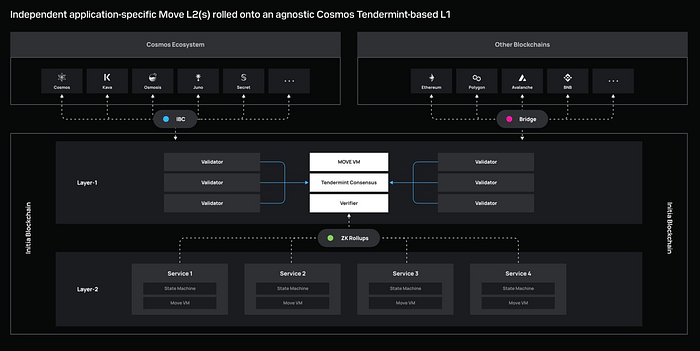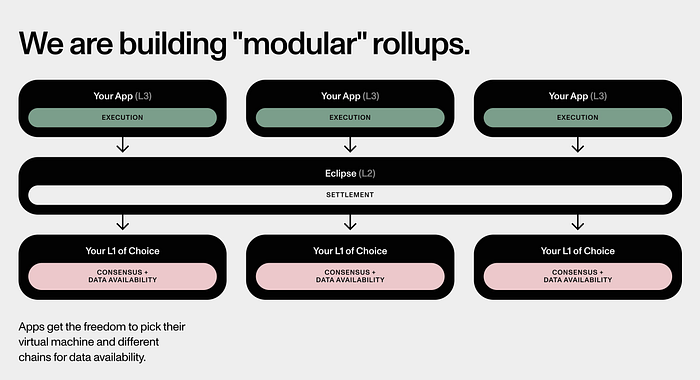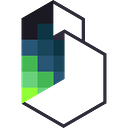Hitchhiker’s Guide to Rollups-as-a-Service

We’ve talked previously how the future will have millions of blockchains — some general purpose, but the vast of majority of them application-specific.
The advent of modular blockchains, Ethereum’s roll-up centric vision, and the Vitalik’s acknowledgement of centralisation for the sake of scalability in his Endgame pretty much makes this vision of the future an inevitability.
So we’ve come to logical conclusion that the future will be millions of application-specific modular chains — but how are they built?
With Rollups-as-a-Service (RaaS) of course.
Many application teams don’t want to think about running infrastructure. Just like how AWS abstracted the complexity of hosting servers, RaaS projects are doing the same for standing up and maintaining blockchains.
In the near future, deploying a new chain will be like creating new web pages or scaling up and down an application — the same way we do now via Docker containers and Kubernetes.
In the past 6 months alone, we’ve seen a slew of announcements from RaaS projects — building low- to no-code products for lightweight, configurable rollups.
RaaS: Rollups-as-a-Service
Here is an exhaustive list of all the current modular blockchain solutions / rollup-as-a-service projects.
The OGs: Cosmos and Substrate
Both Cosmos SDK and Substrate SDK have been around for years — allowing developers to create their own sovereign chains (so not technically modular) or, in the case of Substrate, to connect to the shared security of Polkadot Relay Chain by being a parachain.
The alt-L1s
Polygon and Avalanche were a large part of the alt-L1 narrative during early 2021. They came built-in with proto-modularity: Polygon Edge and Avalanche subnets.
Most notably, Avalanche has worked with games like Crabada and DeFi Kingdoms to create their own game-specific subnet.
Polygon has expanded the scope of Edge — now called Polygon Supernets. With a Supernet, a dApp team can leverage the stake of the existing Polygon PoS validators and create a separate application-specific environment. Over time, Polygon Supernets will also give dApp teams the ability to create a ZK rollup using Polygon ZK technology.
The Ethereum Maxis
Many L2s on Ethereum are thinking about what application-specific rollups looks like on their networks — with notable omissions from Scroll, Fuel, Mantle, Boba, Metis, Consensys’ zkEVM, and Loopring.
OPStack, Optimism’s modular stack, was the architect behind Base — among other forks (like a Minecraft game). They have a Superchain vision of shared sequencers providing synchrony and atomicity between rollups — leveraging shared sequencers.
The OP Labs team has a vision for RaaS L2s to become an “experimentation layer” on top of Ethereum. For example, Ethereum developers can easily spin up a new rollup in order to test new ERCs and EIPs in production — rather than waiting for full-blown enshrined updates to Ethereum L1, or even updates to other more established L2s like Optimism mainnet.
Arbitrum AnyTrust, and its inaugural gaming-optimised deployment Nova, is Arbitrum’s modular solution — allowing for the use of Arbitrum’s execution layer Nitro with the capability for off-chain data availability using a DAC and a failsafe feature to post on-chain to Ethereum L1.
Last week along with its airdrop announcement, Arbitrum announced Orbit — a developer solution to launch L3s on Arbitrum as either complete rollups or AnyTrust instances. Pairing together with Stylus, Orbit allows developers to build applications in C, C++, and Rust in addition to EVM languages like Solidity. Offchain Labs envisions L3s to be leveraged for rapid experimentation: permissionless rollups that introduce new governance mechanisms, modifications to Nitro, etc.
Slush, built on top of StarkNet, provides an SDK to build zkVM L3s on top of StarkNet. Starkware has also famously thought of the concept of Fractal Scaling and arguably started the conversation on L3s.

zkSync is also thinking of fractal scaling and about L3s — with what they’re calling Hyperchains. Leveraging LLVM, Hyperchains are fractal-like instances of zkEVM running in parallel and with the common settlement on L1 mainnet.
Hyperchains can be permissionlessly deployed by anyone — with a customizable modular zkEVM chain stack powered by the exact same zkEVM engine as the main zkSync L2. Developers can choose different virtual machines (e.g., MoveVM), different sequencer designs, as well as data availability (zkRollup, zkPorter, and zkValidium).
Morever, the Matter Labs team has a vision for ephemeral execution enviroments on Hyperchains. For example, a rollup can be spun up to cheaply mint millions of NFTs, the NFTs can be bridged over to another execution layer, and the temporary rollup can be shut down.
Caldera has a vision for 1-click modular chain deployment — initially starting with optimistic rollups. They have a live demo for testnet rollups that is really dope, and are also already live in production on mainnet with gaming customers like Curio.

Stackr is still early, but was an ETH Global winner and seems highly promising. They want to enable the creation of “hybrid applications” leveraging “micro-rollups” — giving rollups the freedom of choice for execution, data storage, and sufficient decentralisation.
Not much is known about Conduit yet either, but it’s related to OPStack for optimistic rollups. They also are aiming for the “1-click deployment” experience.
The Cosmonauts
Dymension’s RDK allows for the creation of RollApps on Cosmos that connect to the Dymension Hub. Dymension RollApps are built with the same tooling as Cosmos SDK — with the main difference being the replacement of modules for consensus-free blockchains (i.e., no validator transition logic) — and are more anticipated to be scalable than vanilla rollups due to not having data publication bandwidth as a bottleneck.
Dymension Hub will allow for hub-and-spoke IBC connections between RollApps and other IBC-enabled chains—benefitting not only for the users but also increasing Dymension Hub’s position as an autonomous network.
Saga is an elastic blockspace platform that allows developers to deploy fully secure, decentralized “chainlets” on demand —leveraging the security of its main validator set.
Saga is supporting multiple underlying platforms for chainlets — including Cosmos appchains, Celestia rollups and Polygon Supernets. Like other RaaS projects, Saga is laser focused on gaming use cases and will support any technologies the gaming industry demands.

Initia is a modular solution is also going after the gaming market. They’re leveraging MoveVM for the execution layer, ZK proofs, and Cosmos SDK for rapid settlement and data availability. Rather than just focusing on L2 infra, Initia plans to flesh out their L1 ecosystem for composability and cross-pollination between L2s through what they call “The Lobby Thesis”.

Evmos plans to develop the Evmos SDK that will allow developers to easily build with Ethermint and launch new EVM-compatible app-chains on Cosmos.
Berachain recently announced Polaris, a redesigned blockchain framework that allows the Ethereum Virtual Machine to be integrated with any consensus mechanism — with Cosmos SDK/Tendermint to start. The team will also build additional developer tooling and infrastructure in order to make building with Polaris seamless — for example, block explorers and wallets.
Eclipse is building a settlement rollup that allows SVM and other VM execution layers to be built on top and use Cosmos and Polygon and eventually other L1s for data availability.

The Celestians
Rollkit by Celestia (formerly Rollmint and Optimint before that) is a modular framework for rollups that allows developers to create sovereign rollups or optimistic rollups (soonTM) with a modular data availability component. Rollkit has a generalised DA layer interface that will allows for any arbitrary DA layer to be plugged in — with a controversial integration with Bitcoin.
Astria is a settlement rollup for execution layers using Celestia for data availability.
Fractal is a hub for building zkVM rollups.
Sovereign Labs is building the Sovereign SDK for the “Internet of Rollups”, creating sovereign zk-rollups using any L1 for data availability and ordering and any LLVM-compatible proof system for zk-proving (e.g., RiscZero or Nil Foundation)
Other Homies
Artesi is building “full stack” rollups with off-the-shelf tooling like a block explorer and MPC wallet included.
Alt Layer is focused on the creation of “flash layers”, ephemeral optimistic rollups for time-bound use. They are using Substrate SDK.
Cartesi (not to be confused with Artesi) is creating a blockchain SDK for optimistic rollups with a Linux OS that compiles to Risc-V.
Opside is providing zk-rollups as a service using their innovative “three layer” platform.

dApp-chain Teams
OK phew — we’ve finally covered all the solutions making it easier to build a modular chain, but who is actually building new chains?
Three major categories: gaming, DeFi, and creator economy.
Gaming
By far, gaming is the most cited use case for RaaS project — many of them are solely focused on the gaming use case.
GameFi has long been the pot of gold at the end of the rainbow for crypto — with “gaming chains” emerging over the years with the likes of Efinity, Flow, Enjin, ImmutableX (StarkEx first, and now on Polygon zkEVM), and others.
It makes sense. Games need completely different parameters than financial applications: lower security, higher throughput, high storage capacity, etc.
RaaS projects are joining the chase for web3 gaming.
Decentralised finance
More specifically, standalone financial applications.
Applications that do not require the composability of a shared execution layer work well in a modular context. Use cases like payments (Chai from Terra 🥲) and derivatives (e.g., dydx, perps, structured products) come to mind.
Creator economy
Kind of a catch-all bucket, but projects in web3 social, token gating, community/social tokens are actively working on their own application-specific modular blockchains as well.
Also makes sense because these applications are also self-contained and don’t suffer from the lack of composability that currently persists in cross-chain.
The Long Road Ahead
I’m insanely bullish on the proliferation of blockchains leveraging the modular stack and Rollups-as-a-Service solutions.
However, I also recognize that we’re still — as it seems has been the case for my entire five-year crypto career — so early.
Modular stalwarts — like Fuel, Celestia, and the zk rollups — have still not launched. Most (announced) RaaS projects are either on in alpha or have manually-configured, permissioned deployments.
Not to mention the nascency of application protocol teams considering deploying their own dapp chains. As it stands right now, it’s not a no-brainer for any dev team to build an app-specific modular chain:
- Connectivity and composability is lost when moving away from a shared state machine
- Existing infrastructure like RPC endpoints, block explorers, and wallets don’t work off the shelf, and running the infra on your own is cost intensive.
- Liquidity is fragmented, and a community needs to be built from the ground up. There’s no network efforts to inherit from an underlying base chain.
And finally, there’s the lingering worry if this is just “picks and shovels all the way down”.
In addition to robust developer tooling, the space needs marquee applications that will bring in a tidal wave of new users in the next bull run. They need to solve real user pain points that will arrive in the future of a million chains: issues around composability, moving value cross-chain, or even the abstraction of chains all together.
Something that I’ll be tackling in my next endeavor 👀
Acknowledgements
Thanks to conversations with the teams from Celestia (s/o Jacob and Joseph), OP Labs (s/o Binji), Offchain Labs (s/o Bharat), Matter Labs (s/o Omar), Scroll (s/o pseudotheos), Fuel, Mantle, Polygon, ICF, Slush, Starkware, EigenLayer, Eclipse, Saga, Dymension, Sei, Caldera, Sovereign Labs, Initia and Stackr.
I appreciate the patience in putting up with my dumb questions :)

